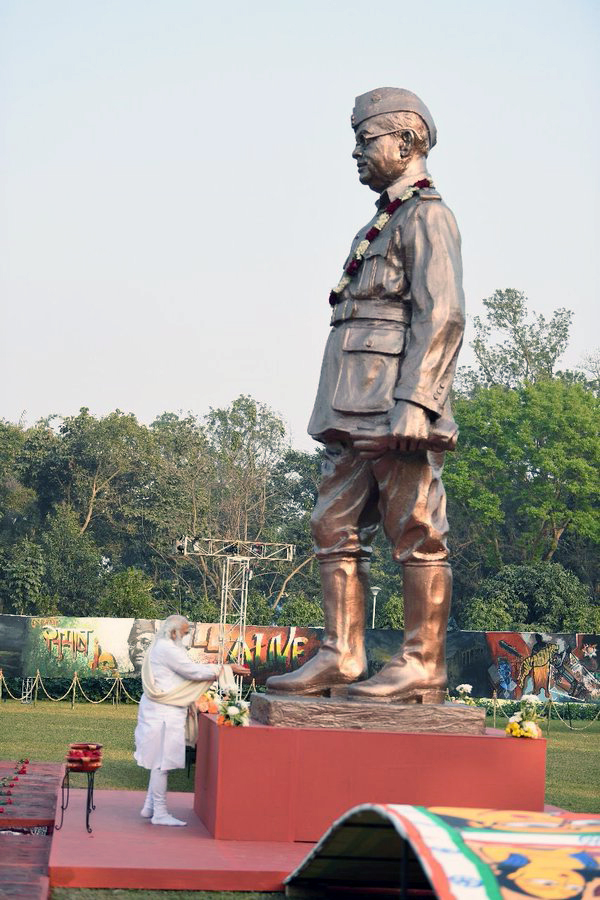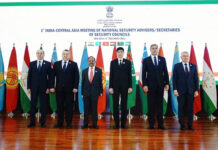Bose Got His Due During “Azadi ka Amrit Mahotsav”
The birth anniversary of freedom fighter Netaji Subhas Chandra Bose is celebrated every year on 23 January. He is considered to be one of the most iconic and influential leaders, who played a significant role in gaining independence from the British Rule.
Bose’s birth anniversary is marked as Subhas Chandra Bose Jayanti or Netaji Jayanti across the country. In states such as West Bengal, Jharkhand, Tripura and Assam, the day is an official holiday. This year, the country observed Netaji’s 125th birth anniversary. The government declared that Bose’s birth anniversary will be celebrated as Parakram Diwas. Republic Day 2022 celebrations began from 23 January instead of 24 January to include the birth anniversary of Netaji.
Prime minister Narendra Modi announced that a grand statue of the freedom fighter would be installed at India Gate “as a symbol of India’s indebtedness to him” and until the statue is completed, a hologram statue, which was unveiled on 23 January, would be present at the same place.
Bose’s Life
Bose was born in 1897 in Odisha’s Cuttack to Prabhabati Bose and Janakinath Bose. From a very young age, Netaji considered Swami Vivekanand as his spiritual guru.
To be a part of the freedom struggle in India, Netaji left gave up on joining the Indian Civil Service (ICS) and came back from England.
He became Congress president in 1938. After reelection in 1939, differences arose between him and Gandhi. The senior leadership in the Congress supported Gandhi, and Bose resigned as president and was eventually ousted from the party.
Differences with Congress
Subhas Chandra Bose and Vinayak Damodar Savarkar – the two stalwarts of India’s independence movement – worked in close coordination and played an instrumental role in forcing the British to leave India after World War II.
Both of them had their differences with Mahatma Gandhi and Jawaharlal Nehru-led Congress and chose a different path to end the colonial rule focusing on the militarisation and a straight fight on the battlefield against the British.
After being deprived and outmanoeuvred of his legitimate second term as Congress president by Mahatma Gandhi’s machinations in 1939, Bose had remained, more or less, on the sidelines of the freedom struggle. He had also parted company with Jawaharlal Nehru, forging his own socialist, political party, Forward Bloc. Given that he differed with the dominant Gandhian view that India could be liberated by non-violence means alone, he had felt frustrated and underutilised.
It was Savarkar, who suggested to Bose, on 22 June, 1940 that he should try to leave India and undertake the risk of going over to Germany to organise the Indian forces there fallen in German hands as captives and then with German help should proceed to Japan to join hands with Rash Behari Bose.
Escape to Germany and Japan
Bose escaped from house arrest in Calcutta on 17 January 1941. Dressed as a Pathan, he was driven by his nephew, Sisir Kumar Bose, to Gomoh, now Netaji Subhas Chandra Bose, station in Jharkhand. From there, he travelled overland and in disguise to Peshawar, then to the Soviet Union as the Italian Count Orlando Mazzotta, escorted from Afghanistan to Moscow by NKVD or the People’s Commissariat of Internal Affairs.
The Soviets, however, were not interested in helping him or the cause of Indian independence. They handed him over to the German Ambassador.
Flown in a special plane to Berlin in April, Bose met foreign minister Joachim von Ribbentrop, Heinrich Luitpold Himmler, Head of the Schutzstaffel (SS) and the Gestapo. Bose also met the German Führer und Reichskanzler, or “Leader and Chancellor”, Adolf Hitler.
During his stay in Germany, Bose founded the Free India Centre in Berlin, raising a small army of 4,500 soldiers called the Indian Legion consisting of British Indian prisoners of war captured from North Africa. But Germany was unable to devote the resources or manpower to free India, nor was an overland campaign through so many territories or terrains feasible.
Japan, on the other hand, had been spectacularly successful in the eastern front of World War II, with victory after sensational victory. Following the dramatic fall of Singapore on 15 February 1942, the mighty British empire itself did not look invincible.
A large number of British Indian soldiers were held captive in forced labour camps by the Japanese. In Europe, on the other hand, the tide of war began to turn against Germany. Bose, therefore, decided to try another strategy, to approach Japan instead of Germany, for help. And to invade India from the East rather than the West.
In February 1943, Netaji boarded a German U-180 submarine at Laboe, Northern Germany, first heading westward, across the heavily mined North Sea.
Bose transferred to a Japanese I-29 submarine after rounding the Cape of Good Hope. On 11 May 1943, he finally reached Tokyo in Imperial Japan, after a short stop in Singapore. In Tokyo, he received the support of Japanese Prime Minister Hideki Tojo as well as the army high command.
Raising of the INA
In Japan, Bose joined Rash Behari Bose. Both resolved to form an Indian National Army under the direct command of Indian officers who would conduct the campaign to liberate India.
An Indian Independence League (IIL) was established and its conference was held in Bangkok in June 1942. Over 100 delegates participated from Burma, Malaya, Thailand, Indo-China, Philippines, Japan, China, Java, Sumatra, Hong Kong and the Andamans. The conference raised the tricolour flag of India and also invited Subhas Bose to East Asia. Indian soldiers who had been captured by the Japanese in the war but had now sworn allegiance to liberate their motherland and eschew the British were also recruited in this group. More than 25,000 volunteers swore to join the INA that was formally set up on 1 September 1942.
Bose’s Indian National Army was the second such army raised in Singapore. The first attempt, made by Rash Behari Bose in 1942, after the fall of Singapore, failed. It was Netaji who was destined to make it happen. He landed in Singapore from Japan on 2 July 1943 to an enthusiastic welcome, assuming command of the Indian National Army on 4 July 1943. Addressing his troops the following day, he gave them the resounding call, “Chalo Dilli” or “Onward to Delhi.”
Subhas was made the leader of the Indian independence movement and hailed as Netaji by his followers, with the war cry of ‘Jai Hind’. Bose called his army Azad Hind Fauj (Free India Force). Under Bose, INA’s motto was Ittefaq (Unity), Itmad (Faith) and Kurbani (Sacrifice). Nationalism was no less than a sort of religious faith.
Declaration of Independence
Indians would do well to remember that before we became a republic or even achieved Independence, great freedom fighters and revolutionaries had already announced India’s Independence.
India’s independence was proclaimed from Singapore on 21 October 1943, with the formation of an interim government, which eleven countries actually recognised.
In a motivational speech for the Indian National Army at a rally of Indians in Burma on 4 July 1944, Bose’s most famous quote was “Give me blood, and I shall give you freedom!” In this, he urged the people of India to join him in his fight against the British Raj.
1943 -45
The INA’s first commitment was in the Japanese thrust towards Eastern Indian frontiers of Manipur. INA’s special forces, the Bahadur Group, were involved in operations behind enemy lines both during the diversionary attacks in Arakan, as well as the Japanese thrust towards Imphal and Kohima.
The Japanese also took possession of Andaman and Nicobar Islands in 1942 and a year later, the Provisional Government and the INA were established in the Andaman and Nicobar Islands.
On 6 July 1944, in a speech broadcast by the Azad Hind Radio from Singapore, Bose addressed Mahatma Gandhi as the “Father of the Nation” and asked for his blessings and good wishes for the war he was fighting.
After the Japanese defeat at the battles of Kohima and Imphal, Bose’s Provisional Government’s aim of establishing a base in mainland India was lost forever. Still the INA fought in key battles against the British Indian Army in Burmese territory, notable in Meiktilla, Mandalay, Pegu, Nyangyu and Mount Popa.
A large proportion of the INA troops surrendered. The remaining troops retreated with Bose towards Malaya or made for Thailand. Japan’s surrender at the end of the war also led to the surrender of the remaining elements of the Indian National Army. The INA prisoners were then repatriated to India. The British Raj, though never seriously threatened by the INA, tried 300 INA officers for treason in the INA trials, but eventually backtracked.
Controversy over Bose’s Death
Many refuse to believe that Bose’s death occurred from third-degree burns on 18 August 1945 after his overloaded Japanese plane crashed in Japanese-ruled Formosa (now Taiwan). Bose’s ashes are stored in a golden pagoda at the Renkōji Temple, Tokyo. Some believe that he was transferred to the Russians by the Japanese, where he died at the
Recent declassified files on the inquiries into Bose’s death indicate that he died alone in a Soviet prison in Siberia under Joseph Stalin’s rule.
Two inquiry reports by Shah Nawaz Committee and one-man GD Khosla Commission, set up in 1956 and 1970 by the Congress governments led by Jawaharlal Nehru and his daughter Indira Gandhi respectively, concluded that Bose died in a plane crash at Taihoku airport.
The declassified documents and exhibits in the National Archives raise serious doubts about the veracity of these reports. However, the third and last report of the Mukherjee Commission established in 1999 had trashed the probe findings, though it doesn’t explain what exactly happened to Netaji. Congress MP and diplomat Dr Satyanarayan Sinha (now deceased) deposed before the Khosla Commission that Netaji was imprisoned in cell number 45 of Yakutsk Prison in Siberia. This information was given to him by a former NKVD agent, Kozlov, who had met Bose in prison. Sinha had served in the Russian Army as an interpreter and later in the Indian Foreign Service. The commission ignored all evidence provided by Sinha.











